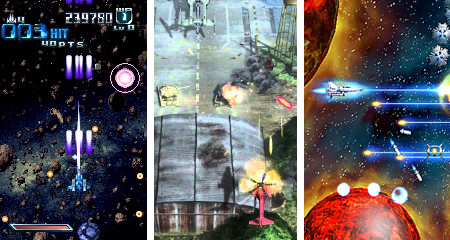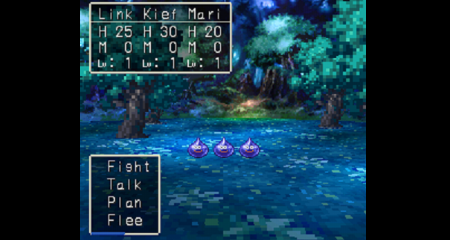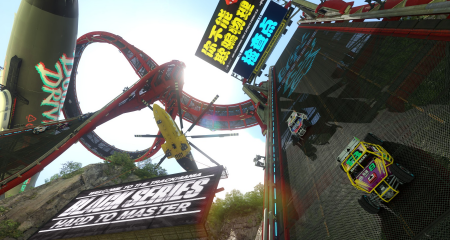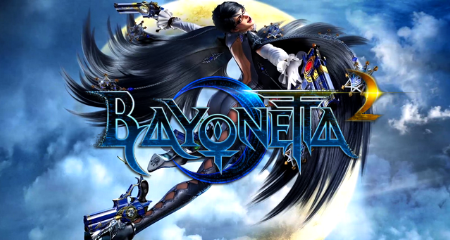If you’ve been following this blog for a while, you probably know that I love, love, love scrolling shooters. A while back I even wrote a massive post about scrolling shooters — I wanted to pick apart the genre in a scholarly way, highlighting notable games and asking questions that would get people thinking about them on a deeper level.
Well, I feel the need to add onto that article. Many of the games I listed in my original article are super rare and super expensive, and it doesn’t do anyone any good to appreciate them theoretically. More than any other genre, scrolling shooters live or die by the fundamental “fun-ness” of play. To that end, I’ve compiled a list of my favorite affordable and available shooters. These are shooters I would vouch for no matter what, but they’re also fun and accessible picks that won’t put a hurt on your wallet.
– PC –

Cho Ren Sha 68K
I’m not much for classics, but Cho Ren Sha is everything you need and nothing you don’t. Every element feels perfectly balanced, as if the creators knew exactly what they wanted before they started programming. Colorful enemies, blazing-fast gunfire, powerful tunes, and a brilliantly simple powerup system (choose: bomb, powerup, or shield!) come together to make for one of the all-time greats. If Cho Ren Sha has a fault, it’s that it only has one background… but hey, it worked for Galaga.
Price: Free
Alltynex Second
Spaceships with gimmicky weapons are a time-honored scrolling shooter tradition, and Alltynex Second brings the heat with *three* separate gimmick weapons in one ship. Normally that would be enough to tank a game under its own excess, but Alltynex Second pulls it off wonderfully. The homing shot takes out small enemies, the power beam tears through bosses, and the laser sword cancels enemy bullets as it hacks away at their mechanized faces. There’s more than a little bit of hack-and-slash DNA in this one, and cutting apart enemies piece by piece never loses its appeal.
Price: $8 on Steam
Crimzon Clover: World Ignition
“World Ignition” is more than just a flashy subtitle. When Crimzon Clover exploded onto Steam, scrolling shooter fans went totally bonkers. That’s because Crimzon Clover nails every aspect of bullet hell design—hardcore action, non-stop explosions, over-the-top visuals, and an endless supply of glittering point items. There’s a wealth of content, with four different arcade modes and two novice modes for people (like me) who just aren’t that great at bullet hell games. Crimzon Clover demonstrates yet again that a one-man indie can outperform even the biggest studios. If you want to experience for yourself the intricacy and adrenaline of bullet hell shooters without the costly import prices, Crimzon Clover is unmissable.
Price: $10 on Steam
Also try: Danmaku Unlimited 2, Hydorah, Jamestown, and Kamui
– Xbox 360 –

Score Rush
Score Rush combines all the best elements of Geometry Wars with the kaleidoscopic gunfire of a bullet hell. Twin-stick controls, 4-player multi, and tons of psychedelic particle effects make this an incredibly fun and accessible shooter. It’s just about the only scrolling shooter that you can have an entire room of friends playing in no time. Such is Score Rush’s simplicity and curb appeal—when I think of no-brainer 360 purchases, Score Rush is at the top of the list.
Price: $1 on Xbox Live Indie; Free on PC
Raiden Fighters Aces
Raiden Fighters Aces offers a rare glimpse into what scrolling shooters looked like just before bullet hells changed the genre completely. There aren’t any intricate patterns of slow-moving bullets here—In Raiden style, the action is blisteringly fast, emphasizing twitch reflexes and wide dodges in order to avoid enemy sniper shots. All three Raiden Fighters games are included on-disc, and between them there’s a massive number of playable ships, each with their own weapons, stats, and bombs. And that soundtrack, holy crap. What it lacks in melody it makes up for in raw intensity.
Price: ~$15
Deathsmiles
I could tell you all about what a great developer Cave is and blah blah blah but instead I’ll say that this game features a giant rotting cow named Mary as an end of level boss, and I think that really says everything right there. Deathsmiles’ Halloween motif leans cutesy rather than gory, but underneath the cheese is a smart shooter that cuts through the typical bullet hell crap. Level select, per-level difficulty select, and simplified bullet patterns mean that you don’t have to be an absolute monster to beat Deathsmiles. Even so, there’s more than enough for players to bite into as they gain skills and start chasing high scores.
Price: ~$10
Also try: Akai Katana, Ikaruga, and Chronoblast
– Playstation 3 –

Zanac X Zanac
Allow me be a crazy person for a second and tell you that one of the best scrolling shooters on PS3 is actually an enhanced port of an NES game. Zanac is a thing of subtle beauty, by which I mean it’s actually kind of hideous and could easily fool you into thinking it’s total garbage. But oh man, don’t tell that to Zanac. Because Zanac hears. What sets Zanac apart from other scrolling shooters is that it features randomized waves of enemies, sent by the AI that is Zanac. How many shots you’re firing, what powerups you pick up; everything is analyzed by Zanac and every game of Zanac is customized to kill you, specifically. The powerups in this one are just incredible—absolutely top of class. Plus there’s a really sweet challenge mode that could keep you playing, like, forever. Oh, and also a really good Playstation version included called Zanac Neo. Yeah, there’s that, too.
Price: $6 on PSN
Under Defeat HD
Under Defeat boasts the sort of elegant beauty that you’d never expect from a scrolling shooter about World War II helicopter pilots. Every scene is bursting with detail, and the stunning particle effects and dynamic smoke highlight the action across stages of forested gun-emplacements, massive naval fleets, and bombed out military bases. Even though the game takes place in a fictitious alternate timeline, a strong sense of realism makes Under Defeat extremely compelling. The “lean into your shots” control scheme is novel and fun, and the scoring system utilizes the player’s vulcan, cannon, and rocket powerups in a simple and satisfying way. To top it off, this version also includes a widescreen, twin-stick mode with a remixed soundtrack courtesy of the always-great Yousuke Yasui.
Price: $10 on PSN
Gradius V
Gradius V may be the ultimate sidescrolling shooter. I don’t mean that it’s the best, or that it’s my personal favorite. What I mean is that Gradius V seems to carry the entire legacy of the genre on its shoulders as you play—It’s monolithic, majestic, and impossibly slick, with tight level design and spectacular boss battles. It’s also ruthlessly difficult, requiring players to memorize certain routes to make it through. That’s all part of what it means to be a Gradius game. But the system of unlockable continues means everyone can eventually play Gradius V to the end, and really, I’d say this is the best game in the series since the original Gradius codified the genre in 1985. Play them both.
Price: $10 on PSN
Also try: Castle Shikigami 2, Velocity
– Wii (and Wii U) –

.
Blast Works
I’m not sure I can call Blast Works a great game; hell, I’m not entirely sure I can even call it a good game. What it is, though, is a uniquely fun game, thanks to an irresistible premise: Blast Works is essentially Katamari Damacy as a scrolling shooter. Every enemy you kill can be latched onto any side of your ship; they contribute their firepower to yours and also act as a giant meat shield. By the end of the stage, you’ll feel like the end of level boss, because your fighter craft will be have a hundred other guns attached to it. All that craziness, plus the game has a robust level and ship editor. Blast Works is fun with friends as well, and… that’s why you bought your Wii, isn’t it? Ah, you were in it for Wii Fit. Nevermind then.
Price: ~$5
Sin and Punishment 2
This game is just bonkers. Sin and Punishment 2 is like a rail shooter, lightgun game, and scrolling shooter fused together and jacked up to eleven. There are a bajillion things to shoot at, and the level designs are truly inspired. There’s an overgrown ruin of destroyed Tokyo, a hoverbike chase on a not so abandoned highway, and a flight down a literal water tunnel, where giant morays and enemy ships burst through the walls of water to attack. That’s to say nothing of the bosses, which are massive, frequent, and phenomenal.
Price: ~$15
Wii Virtual Console
There aren’t many great retail shooters for Wii, but it still has one of the best collections of scrolling shooters on any system thanks to the Virtual Console. There are sooo many great and otherwise hard to find games; hell, it was the Wii Virtual Console that got me deeply into shooters in the first place. Take to the skies in your mech and blow apart neo-feudal Japan in MUSHA; headbang hard with the heavy metal soundtrack and awesomely mythological monsters of Lords of Thunder; destroy cute-em-up baddies as a Turbografx-16 videogame system itself in Star Parodier. And while you’re at it, definitely try out Gate of Thunder. It’s my favorite sidescrolling shooter of all time.
Price: $8-9
Also try: Blazing Lazers, Fantasy Zone, R-Type and R-Type III, and Soldier Blade
Those are my personal picks for fun, affordable scrolling shooters. Hopefully you discovered a new favorite or added something to your never-ending list of games to check out. Narrowing down this list was tough; scrolling shooters are a huge genre dating back to gaming’s infancy, and I had to cut a few of my absolute favorites. Maybe I missed a few of your favorites, too.
On that note, I’m gonna turn things around and ask you: What’s your favorite scrolling shooter?























